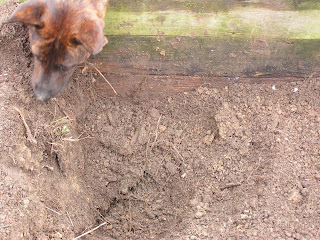Almost everything planted in the hot boxes has germinated (In bed 2 the only thing not showing is the dyer's greenweed) I'll get some photos for the next post. A few of the cuttings I took from my last project are showing signs of life so I may have some more plants for the forest garden than I thought.
In the big pots indoors there's been signs of life but unfortunately a rat has been rummaging in the pots and I don't know how much will survive that. (Can't avoid rats here it's one of the reasons for having raised platform beds)
My plant collection looks like it's been hammered by deer and the elements. I'll list what's survived when I know later and when we get going with the forest garden. A lot of the plants I've been planting in the herb garden are for understory plants and for the edges. I already planted a couple of cider apples, a couple of dessert pears, some cobb nuts (Named varieties I'll list them when we get into the forest garden) I have ginko biloba, honey locust, silk trees and some mulberries to go in as well as a bunch of grape vines. Until the plants get well enough spread and established we're vulnerable to losing species or varieties, the deer are remorseless and Star doesn't seem to have deterred them very much.
The strawberry beds I put in last September have been hammered. I won't know how bad the damage is for a few weeks yet. The grass is beginning to grow a bit so the deer are likely to be pressuring my plants a little less soon.
The weather has been much warmer recently, spring is definitely here, there have been a couple of t-shirt days.
The mullberries stratifying outside were brought back in and there's a hint of life there.
I need to repot my pineapples and the passiflora edulis soon as they're beginning to grow again. Pineapples are easy. You take the top off a pineapple, pull off the bottom few leaves, dip it in rooting hormone or rub it with crushed willow bark (It acts like rooting hormone). It'll grow on a window sill or in a hot bed over the winter and in about five years you'll have a pineapple and a bunch of baby plants.
I planted up the small bed Leia dug with a white papaver somniferum called Shayma. I want the seeds and I also spread some seeds around disturbed areas. I thought some blocks of white would look nice.
Planted Mertensia maritima and passiflora edulis in the end of hot bed 2, I want to try some of the passiflora in the polytunnel and see if it can survive there. (It's my favourite fruit if you want to grow some just get a fruit from the supermarket and sow the seeds at 30C daytime and 20C night time temps or you can throw it in a hot bed like I did and hope for the best)
Two of my tree tomato Cyphomandra betacea cuttings seem to have pulled through.
Anyway here's what's in herb bed five now from left to right (I'll draw a diagram when I've finished working out what I'm doing with the rest of the space and I need to find out what's still alive in the herb garden)
Mentha spicata var. crispa Curly mint
Origanum vulgare hirtum Greek Origano
Scutellaria lateriflora Virginian skullcap
Eschscholzia californica Californian poppy
Centaurium erythraea Centaury
Lycopus europaeus Gypsywort
Petroselinum crispum Parsley Italian Giant
Origanum vulgare hirtum Greek Origano
Scutellaria lateriflora Virginian skullcap
Eschscholzia californica Californian poppy
Centaurium erythraea Centaury
Lycopus europaeus Gypsywort
Petroselinum crispum Parsley Italian Giant
Allium fistulosum Red Welsh onion
Filipendula Ulmaria Meadowsweet
Borago officinalis Borage (Blue dye from the flowers of this, the flowers are also said to give you courage by making you produce adrenaline. Warriors used to take borage flowers before battle)
Malva sylvestris Mallow (Contains mucilage good edible and medicinal plant)
Papaver somniferum Shayma
Chrysanthemum coronarium Shingiku greens the flowers make a chamomile substitute (Got to find my chamomile seeds)
Malva sylvestris Mallow (Contains mucilage good edible and medicinal plant)
Papaver somniferum Shayma
Chrysanthemum coronarium Shingiku greens the flowers make a chamomile substitute (Got to find my chamomile seeds)




















